Kilimanjaro Trip Preparation
Be in the know before you go on your trip to Kilmanjaro. Below are some helpful tips to prepare for your trek up Mount Kilimanjaro.
Is Kilimanjaro right for me?
Climbing Kilimanjaro is an incredible experience. However, like with any challenge, there will be some bumps along the way. One thing to remember is that things in Africa happen at a different pace. You may feel like things are a bit chaotic, but it is the normal way of life here. Things do not always work and conditions might not be what you would expect at home. However, the people are very friendly and keen to help.
It is not surprising to see people begging. Please do not give in and perpetuate this damaging practice. Tips are customary but should be given to Castro at the gate on the last day for distribution. This is much better than giving individuals money privately or secretly, which some people do because they think they're doing it 'right', but this is never the case and it always causes problems long after you have left. We have a system in the company which the staff understand and recognise and like, and Castro is a good and honest boss who will not exploit the staff.
If you would like to learn more about some of the difficulties of spending many days in a mountain camp, see our Mountain Realities page.
Flights to Kilimanjaro
Kilimanjaro International airport (JRO) is the most convenient point of entry to Tanzania, as it is only 48 kms from Moshi Town. A flight to JRO from the UK takes about 9 hours and there is a daily flight with KLM via Amsterdam or you can fly via Nairobi with British Airways or Kenya Airways. There are other routes via the Middle East and also via Ethiopia and Istanbul.
If you are flying on the day flight with BA leaving at around 10 am to Nairobi and changing onto the Precision Airways flight to Kilimanjaro in the evening then do note that the time between the flights is very short and luggage very often does not make it.
Another option is to fly to Nairobi and take a coach to Moshi. The coach costs $80 return and takes about 7 hours. Note that you will need to get two visas if you choose this option – one for Kenya and one for Tanzania, plus if you are in Kenya for longer then 12 hours then you will also need a yellow fever vaccination for entry to Tanzania.
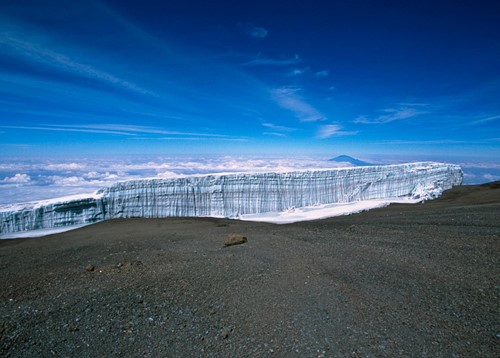
Receding glacier line of the permanent ice sheet on Mount Kilimanjaro.
Baggage
We have our own registered company, Adventure Alternative Tanzania and a guesthouse in Tanzania. The MD is Castro who has been with us for many years. You can mark your baggage with the following details
Company correspondence address: Adventure Alternative Tanzania, PO Box 1383, Moshi, Tanzania
Physical address: Hotel Keys Lodge, Mbokomu Road Road, Moshi. +255 27 275 2250
Visa for Tanzania
You can buy your visa on arrival in Tanzania very easily. For most nationalities, it's US$50, though there is a higher charge for the US and some other nations at $100, payable in US dollars. You do not need a passport photograph. You need a yellow fever certificate only if you are coming from a country with endemic yellow fever.
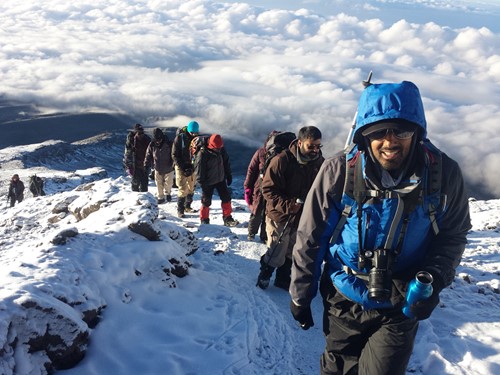
Trekking in the snow, high above the clouds on Kilimanjaro. Excited for summit day!
If you are flying into Nairobi and then travelling overland to Tanzania you will also need to purchase a Kenyan visa, which is done online and in advance through an e-visa system. Please check the Kenyan High Commission website before travelling to check the latest prices for visas. If you are transiting through Kenya, in that you are arriving into Nairobi by air and catching an onward flight to Tanzania then you do not need a Kenyan visa, unless you plan to leave the airport. One way coach transfer from Nairobi to Arusha is approximately $60 each way.
Vaccinations and Travel Health
You will need to visit your GP prior to your trip to discuss vaccinations. You do not need a yellow fever certificate to enter Tanzania unless you are entering from another country where yellow fever is prevalent. This does include Kenya, so if you are coming in overland from Nairobi, having spent more than 12 hours there, then you should have one.
Trip Insurance for Kilimanjaro
For treks and climbs going to altitude or remote regions, you will need to check carefully that you get the right kind of insurance coverage. It is also important to make sure that you have cancellation cover.
We encourage people to buy insurance as soon as you have booked your flight and trip, in case there is a need for cancellation. Do also take your papers with you and make sure your tent mate knows where it is, in case somebody else needs to make a phone call for you. Make sure that your give your insurance information to Castro when you're in Moshi so he can pass it to the Helicopter search and rescue company if an evacuation is necessary.
For people in the UK looking to buy a travel policy covering Kilimanjaro then try True Traveller, or Sportscover Direct, World Nomads, Insure and Go, JS Insurance, Covered2Go or the Post Office. If you are climbing regularly and looking for an annual cover then the British Mountaineering Council or the Austrian Alpine Club offer very good policies.
Money
The local currency in Tanzania is the Tanzanian shilling. Though be careful not to mix up Kenyan and Tanzanian Shillings as there is a 20 times difference in value! You can check the current exchange rate on xe.com. You can buy Tanzanian shillings from some outlets in the UK but otherwise change your money on arrival.
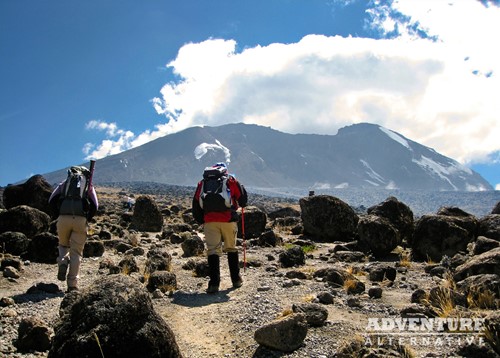
Two trekkers make their way towards Mount Kilimanjaro along the Machame Route.
There is an ATM in town which takes Visa and Mastercard and there is a bank with forex facilities. Do also remember to have small denomination notes because many local places will not be able to offer change for large notes. You can take sterling, euro or dollars, and change it easily, including small amounts at the hotel desk. If you are travelling from Northern Ireland or Scotland then remember to bring Bank of England sterling notes, not the Northern Irish / Scottish sterling notes which are not recognised.
Arrival
Whether you arrive at Kilimanjaro airport or the Coach Station (after an overland connection from Nairobi), you will be met on arrival by Castro - director of Adventure Alternative Tanzania or one of our other guides. They will be holding an Adventure Alternative name board or possibly one with your name on it. Do have a good look around if there are a number of other company reps there, and note that our staff are not allowed into the baggage hall so you will need to come right out into the arrival area.
The charge for an airport transfer is up to £40 / $50 per vehicle (3 / 4 people) per transfer, which is payable to Castro in any currency. We don't include this as standard in our trip fee as some people arrive by air, others by road so it's not applicable to everyone on a trip. A standard airport taxi fare is about USD$80.00.
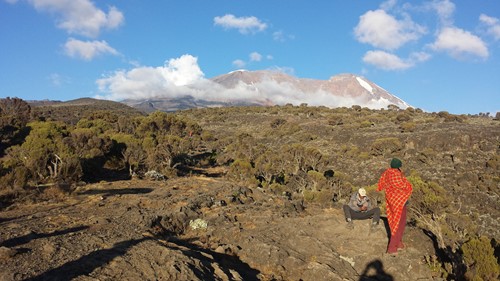
The Roof of Africa dominates the skyline.
On arrival at your hotel, Castro will introduce you to our team and brief you on your safari or climb. The briefing is very relaxed and will cover everything that you will need to know about your trip.
Please note; sometimes arrival day can be a bit busy for Castro if a large number of people are arriving at different times. He or other staff may be back and forth to the airport all day and may spend a lot of time just waiting at the arrivals hall. In this situation, you may be left to relax at the hotel for some time before the group is all together. It is obviously much easier to brief everyone all together so it is likely that we may wait until later on for a full mountain briefing. In the meantime, if you have any questions or are unsure about anything then do call Castro or ask the hotel staff to do so. He is usually only a short drive away if he is not at the hotel.
Electrical
In most parts of Tanzania, they use the same 3-pin (type G) plugs as in the UK. The vast majority of UK electrical devices should charge and work fine. However, the electrical supply in Tanzania is not as closely controlled or as reliable as the UK. If you have any very expensive equipment then please be aware that an electrical surge or voltage/frequency change could potentially affect it. An expert might be able to advise on surge protectors.
Kilimanjaro Daily Routine
How much will you carry?
We use porters to carry the bags and the gear and the food, so you can concentrate on your climb of Kilimanjaro but you will be expected to carry a day sack with some of your own personal equipment which you need for the day such as water, spare clothes, camera and waterproofs. This is normally about 5 or 6 kilograms. Every person will have their own porter carrying their bag so nothing ever gets lost.
The porters are not allowed to carry more than 20kgs in total (including their own clothing so please do not overfill your bags. The maximum per bag is 15kgs. They also carry bags on their heads, even rucksacks, so it is probably more convenient to bring a duffle bag for your gear. We will also put your bags into waterproof sacks in case of rain.
Keeping in touch with home
Your mobile phone should work all the way up the mountain (slightly dependant on which network you are using) as long as you have roaming access. Please bring your own power packs. You may need to walk a little distance to find a spot with a signal. Also, do not expect to get 3G connection, mostly you will find it is voice only.
Keeping dry and warm
There is little doubt that you will have some rain, and it is likely to be in the lower regions around the montane or forest level. Waterproofs are necessary; remember that on the equator the rainy season is traditionally April/May and October/November.
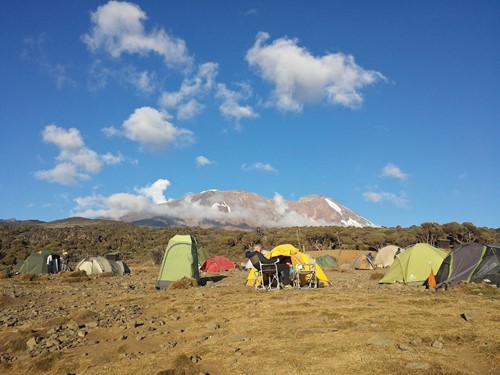
A look at a typical camp set up along the trek to the top of Kilimanjaro.
Expect short-term extreme conditions, i.e. sharp showers of rain, hot sun, gusts of wind, snow and low night temperatures. Clear nights will be colder but more beautiful, and generally, the cloud builds up mid-morning, only to dissipate again with the setting sun.
Above Shira Camp (day 2) you may get snow, sleet and even hail. The ground is more open and exposed so it will be important to have some dry bags for your daysack (or a cover) and all the appropriate clothing for protection against the elements. Up higher at Barafu Camp, it will be colder and windier so the shell jacket is really vital; temperatures can drop dramatically, and there may be snow. Summit morning can be icy underfoot, and very cold (minus 10°C) so good boots with hats and gloves are important.
Work on a ‘wet and dry’ system so that if your T-shirt gets wet during the day, you always have a dry T-shirt and warm top to change into the moment you get to camp. On the lower slopes in the forest you can use a poncho or an umbrella to keep dry, but higher up where it's more windy and cold you will need your waterproof shell. In the evenings you will want a lightweight down jacket or fleece jacket.
On summit night you will want to take all your warm clothes and protective shell, it can be very windy and cold as you go up and especially at Stella Point. Take gloves and mitts if you have them, a warm hat and an extra layer just in case. Don't forget to take your sunglasses and suncream with you for when the sun comes up, and don't forget to put the cream on since the glare off the snow and from the sun itself is very powerful.
At night use your sleeping bag with as few layers on as possible, but keep the top of the bag zipped up to prevent heat loss. If you want to add warmth to the bag then put clothes underneath for extra insulation and put a jacket over the foot end of the bag. Also stack your daypack upright against the end of the sleeping bag to stop your feet pressing against the tent wall.
Sometimes it is the heat and sun that is the problem; always use good quality sunscreen and moisturise well in the evenings. Take a good sunhat and even use an umbrella against the strong direct sunlight.
Daily routine on Mount Kilimanjaro
During your climb of Kilimanjaro generally, 'bed tea' is at about 6.30 - 7.00am, breakfast is between 7.30am and 8.00am, and departure from camp is at 8.30am latest. There is a snack lunch at midday, tea and biscuits around 4 pm and dinner at 7 pm. Summit morning is different; tea and biscuits at 11.30pm and start hiking at midnight or sometimes 1 am.
Most daily hikes take from 4 – 7 hours. The pace is slow and not forced at all. There is a rest at least once every hour and plenty of time to take photos, enjoy the view and chat. When you arrive at the campsite you will find the tents erected and your bags ready to collect. In the morning please have your bags packed before breakfast.
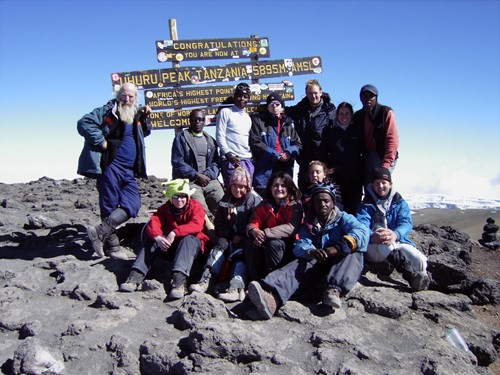
Enjoying a summit celebration on a fantastic sunny day.
Summit day
Expect a long day starting at midnight and getting all the way back down to High Camp by about 4 pm in the afternoon. The route up will be in the darkness and it will be cold and often windy. Do prepare with good warm clothing and protect your extremities and face. From Barafu Camp to the crater rim will take about 6 to 8 hours, and you will arrive with the dawn which is very special. From the rim (Stella Point) it is a further hour to the top, so expect summit time to be between 7 am and 9 am. With an hour on top for photos and enjoying the exceptional view, and feeling absolutely elated, the route down is dusty, loose and quite a strain on the knees. Take it easy and stay with one of the guides; they will split up to cover all the mini groups that naturally form for the descent.
When you get back to Barafu pack your bags for the porters to take down (you should prepare this the night before), take a rest and lunch and then drop down to High Camp which is a further two hours to the edge of the forest. Some people question this, but it is necessary to get lower because Barafu is still at 4600 metres and your body will thank you for losing altitude. It may be the last thing you want to do after having summited Kilimanjaro, but it is necessary!
Tips for Your Guides on Mount Kilimanjaro
Adventure Alternative is proud to pay excellent salaries, but tips are still very much part of the culture and on average you should anticipate $150 - $200 (depending on the number of days) in local currency to give to Castro at the end of the trip.
* Please prepare your tips before going on the mountain by changing any money into local currency and into small denominational notes like 5000 or 10,000 Tanzanian shillings.
* Please give your tips as a group to Castro at the gate. Do not give the tip to the guides or the porters directly.
* Please do not give an individual tip to a specific porter or guide during the climb of Kilimanjaro. This breeds suspicion and encourages them to pester tourists for more money. We try to maintain consistency and fairness at all times. If there is someone who the group feels deserves special mention then tell Castro and by all means add a small amount extra, but make sure that it is given in front of everybody and recognised as a reward for service beyond the usual call of duty. Please also remember that money is not the only way of showing your gratitude, a genuine thank you in front of all the other staff goes a long way to making someone happy. Also have a look at our Tips for Kilimanjaro section here.
Food and accommodation on Kilimanjaro and Mount Meru
Climbing Kilimanjaro involves camping and eating outdoors, and it's a great experience of getting back to nature.
Camping
We camp in tents on the Machame, Lemosho and Rongai Routes. Camping is liberating and really makes you feel as if you are on an expedition! Nothing to worry about, it is enjoyable and hygienic and there is enough privacy and comfort. If you haven’t camped since being in the Scouts or Guides the word should not be associated with hardship or discomfort. Most worries are dispelled on the first day. The tents are two-person North Face mountain tents and we provide comfortable foam mattresses with waterproof covers.
Huts
The huts on Mt Kilimanjaro are wooden buildings with bunks and mattresses and only available on the Marangu Route. Similar huts are also used on Mt Meru. They are dry and warm and can sometimes be crowded. Ten to fifteen people can be accommodated in each dorm and there is no pre-allocation of beds, it is first-come-first-served, so expect to be sharing your hut with strangers.
Toilets
Nearly all the campsites now have newly constructed toilets with long drop facilities. It is important to take a torch with you at night and take a responsibility to keep the huts clean. Going to the toilet behind a bush is strictly forbidden, but we do also bring up our own toilet tent with chemical toilets. If you get caught out on the path then you are allowed to pee behind rocks or bushes, but if you need to go for a poo then the rule is to pack out your own toilet paper in a plastic bag and put it in the rubbish when you come to camp.
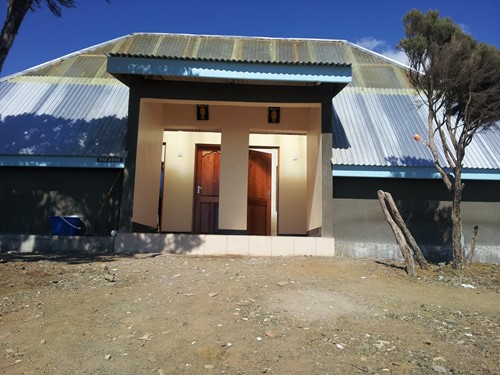
Rubbish
All rubbish is collected by the staff and carried down the mountain. Do not throw rubbish down the long drop (toilet paper is fine) and make a habit of picking up litter that you see on the trail. The responsibility for keeping Kilimanjaro clean is on the shoulders of every visitor. The mess tent will have a rubbish bag hanging by the door so please do use it. In the toilet tents, please put toilet paper in the plastic bag hanging on the hook.
Hotel
The accommodation in Moshi is at the Keys Lodge on Mbokomu Road Road and it is about ten minutes drive from the centre of Moshi and is safe, with a high wall, but that should not stop you from taking all usual security measures with your belongings. The staff are friendly and speak English. There is a bar, a swimming pool, a laundry service, a restaurant, internet, left luggage, TV’s in most rooms, fans in every room and hot water.
Food
All our food is fresh and the meals are tasty and well prepared and served in comfortable mess tents with tables and chairs. Three-course meals with vegetables, fruit, salads, desserts, soups, popcorn, biscuits and a complete range of beverages including herbal teas. We want you to enjoy your holiday on Kilimanjaro and that means good food! Our cooks are all well experienced in Western tastes so expect as an example a soup starter with bread, tomato and avocado side salad followed by chicken casserole with boiled potatoes and julienne carrots with a fresh fruit medley to finish with, and coffee and chocolate for supper. We also provide lots of pasta with vegetables, beef stew, fried fish with potatoes, and fried chicken.
If you have dietary preferences then do let us know and also inform Castro after your briefing in Moshi. The cooks can easily cater for most preferences, although celiac's should bring their own snack supplies from home as gluten-free snacks can be hard to source in Tanzania. Sweets and chocolate are all available in the shops in Moshi, as are things like batteries, but you may want to bring your own supply from home.
Water
We do not bring bottled water on the mountain; we boil all water which comes from the rivers and glacial streams plus it is also treated. The staff will fill your water bottles every evening.
Kilimanjaro weather and seasons
When to Climb Mount Kilimanjaro
Peak seasons are traditionally January to March and June to October, and these are popular times to climb with temperatures in Moshi averaging 22 degrees C and summit temperatures around - 7 degrees C. The rains are in April, May and October and November but nowadays climate change has changed this pattern greatly. December is getting warmer again with clear skies.
The weather on Mount Kilimanjaro can vary dramatically within the same day, from hot to cold, sunny and clear to rainy with clouds. It is hard to predict the weather on any particular day, so be prepared for good and bad weather on any one day. This is an equatorial mountain so don't think in terms of seasons. The annual temperature range is not great, but there will be a great change due to altitude and the time of day.The lower regions can be hot and humid, with temperatures between 20 and 27 degrees Celsius, while summit temperatures can range from 0 to -20 degrees.
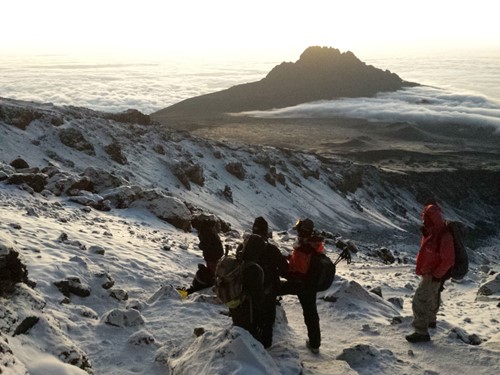
Like all mountains, expect the unexpected. Snow can fall at high altitudes, and summit day can be a full winter experience.
Kilimanjaro offers the remarkable experience of five very different habitats during your ascent. You are passing through cultivated farmland into the equatorial rainforest and then alpine heath, high alpine desert and eventually an icy glaciated environment at high altitude. The summit of Kilimanjaro - Uhuru Point - is about the same altitude as Camp One on Mount Everest.
For the first few days, it is possible to get heavy rain, but this becomes snow and hail as you move higher. Expect a daily routine of clear cold mornings and a build-up of cloud and potential rain towards early afternoon which dissipates again in the evening.
Full Moons on Kilimanjaro
Since the summit climb involves a night ascent, check whether you will have a full moon or not. Some people prefer to summit during a full moon (being the dates below and a day either side of them). We do have a couple of climbs which summit around the full moon however we do tend to try and avoid them as they are very busy times on the mountain. Without doubt summit day is slightly easier if well lit by a full moon (it can still be cloudy during these moons) however for us a head torch is still ample if dark and the real buzz of the experience is when the sun creeps up out of the dark night and hits you like opening a furnace door! So do not assume that a full moon summit is the best time to climb. The night sky on Kilimanjaro at any time in clear conditions is simply fantastic, you can see north and south constellations all at once.
Freezing level on Kilimanjaro is normally at about 4600 metres.

